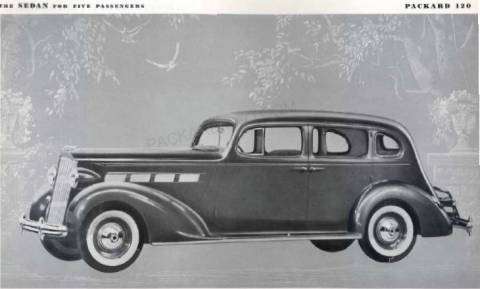|
Re: 1940 356 engine problem
|
||||
|---|---|---|---|---|
|
Home away from home
|
Bill
Sorry. I don't have an answer to the panel questions. Until I take it out of storage, I won't know for sure. The 180 club sedan that we owned in the 1960s and early '70s was black. It was a CCCA Senior car, that was largely original at the time, though I believe it had been repainted and some chrome done. It had the mouton carpeting in the rear, and "blond" dashboard plastic. We drove it about 40,000 miles during the 5 or so years we had it. Ironic story while we drove from Minnesota to Washington state, down to Sacramento, over to Reno, then back home to Minnesota in 1970... We met up with Jim Hollingsworth purely by chance as we stopped at a wayside rest at Donner's Pass. He was driving his 180 club sedan as well. What are the chances????
Posted on: 2013/2/1 17:15
|
|||
|
West Peterson
1930 Packard Speedster Eight boattail (SOLD) 1940 Packard 1808 w/Factory Air (SOLD) 1947 Chrysler Town and Country sedan 1970 Camaro RS 1936 Cord phaeton packardinfo.com/xoops/html/modules/newbb/viewtopic.php?topic_id=4307&forum=10 aaca.org/ |
||||
|
||||
|
Re: 1940 356 engine problem
|
||||
|---|---|---|---|---|
|
Forum Ambassador
|
Quote:
is there any way a hydraulic lifter can push valve higher under actual running oil pressure compared to oil pressure during testing? Packard's info on troubleshooting noisy lifters for 1940 cars has a minimum value of 3-4psi in the lifter gallery at idle and 20 during normal running speed. Those are generally the typical gallery numbers which are lower than main gauge readings as mentioned in several bulletins over the years. They settled on 5 psi at idle after several oil filter plumbing changes in 40-41. Not sure how you did your testing for height but if there was not at least a minimum constant idle pressure maintained in the gallery, it is possible the normal lifter bleed off was fast enough to drop the valve and give a false reading. On the other side, while it's not a likely cause, lifters can increase over design specs if the valve spring is weak or if the gallery pressure is too high. That was another spec Packard mentioned -- not to exceed 55 psi on the gauge for an extended length of time. Doing so could cause the lifter to pump up.
Posted on: 2013/2/2 22:59
|
|||
|
Howard
|
||||
|
||||
|
Re: 1940 356 engine problem
|
||||
|---|---|---|---|---|
|
Forum Ambassador

|
I'm not sure of your 0.250" measurement but the cam lift on the 356 engine is 0.340". Since you didn't have the problem before replacing theheadgasket, I'd say the milling of the head the final 0.012" was the proverbial straw that broke the camel's back - speaking just for myself I NEVER mill a head unless absolutely essential. I'd say it's just about impossible for any resonable oil pressure to counteract the pressure exerted by the valve spring unless the spring was broken or unbelieveably weak - not really likely but worth investigating if nothing else but to eliminate it. Since you've got to replace one valve, I'd do a quick valve job, perhaps just hand-lapping if the surfaces look good. And thereafter check the lifter reserve take up clearance (0.030 to 0.070 between the valve stem and the gauge block inserted into the cam follower. And then I'd do the head test fit with putty or clay on the valve heads to absolutely establish if you have adequate clearance.
Just remember when shopping for another head, it may prove to be no better than the one you have. Depending on what clearance or interference you find, you might consider the earlier suggestion of grinding a bit of relief into the combustion chamber after some additional measurements. PS - I assume a typo when you said the compressed head gasket was 0.004"? should be more like 0.040".
Posted on: 2013/2/2 23:43
|
|||
|
||||
|
Re: 1940 356 engine problem
|
||||
|---|---|---|---|---|
|
Home away from home
|
Did not know about the cam lift spec. That kind of explains everything, my combustion chamber head depth of 0.30 plus the 0.040 of the head gasket is the cam lift! Was more difficult to measure the valve rise accurately as had to keep rotating engine to try to get maximum valve rise. Will think about the idea of grinding the head with a small grinder, nothing to loose at this point. Probably should grind all cylinders as the other exhaust valves have to be right at the edge as well. Can measure grinding progress with straight edge across top of head and a micrometer. Head appears to be thick enough around spark plug area to take a .015" removal?
Posted on: 2013/2/3 1:38
|
|||
|
||||
|
Re: 1940 356 engine problem
|
||||
|---|---|---|---|---|
|
Home away from home
|
One other point about grinding the top of the combustion chamber is the clearance of the spark plug itself. It appears to be just about flush with top of the combustion chamber. Is there such a thing of extra thick spark plug gasket?
Posted on: 2013/2/3 11:28
|
|||
|
||||







